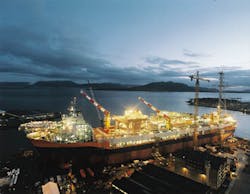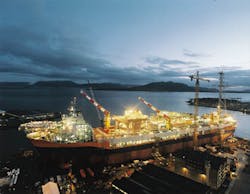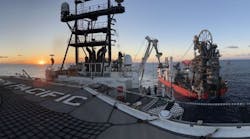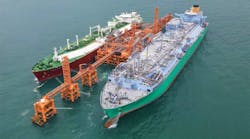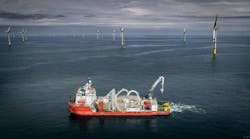Marshall DeLuca
Houston
Global Marine: "no new news" on mergers
"There is absolutely no new news now," is what Global Marine President and CEO Bob Rose recently said of reports on the company's search for a merger. According to Rose, the company has been looking around for several years for various business combinations that might make sense, and the company continues to do that. With merger mania ongoing, many people have now revisited the idea and "Global Marine is interested in talking to companies about mergers. And that tends to have gotten blown out of proportion."Rose attributes the recent reports of Global Marine's merger search to his being very outspoken in his beliefs that the industry needs consolidation, and that Global Marine would like to be a "consolidator."
"We are just not saying no. If it is done in the right terms and conditions, we would be more than happy to pursue it, because I for one believe that it needs to be done in our business. We are seeing our customer base shrink. It seems that the drillers are some day going to have to consolidate."
Rose believes that although it is the next logical step, consolidation for drillers does not offer the cost savings that it does for oil or service companies. "In terms of our total cost, so much of it is attributed to the rigs we operate. A small percentage is attributed to the general administrative cost. So when you put two drillers together, unless you retire a lot of rigs, the only thing you can focus on is that general administrative cost, which is very small in the overall schemes of things."
Rose added, "If you put two drillers together, you may save $4-6 million the first year, and you might improve upon that later, but it depends on the two drillers, and where there's overlap in the companies."
This merger speculation was precluded by the completion of the merger between R&B Falcon and Cliffs Drilling. The merger adds 16 jackups and three platform rigs to R&B Falcon's fleet, giving them 42 jackups, the largest fleet in the world.
In other Global Marine news, Global has signed a $144
million, 3-year drilling contract with EEX for operation of
its Glomar Arctic I semisubmersible in the Gulf of Mexico. The rig, currently equipped for 2,800 ft water depth operation, will be upgraded to 3,400 ft. The upgrade will require no shipyard work and the contract will begin upon completion of the rig's current contract in mid-1999. EEX has an operation to extend the contract for as much as two years following the initial three-year term.
Nigerian MOPU conversion completed
ECL of Louisiana has completed the conversion of the Ocean Chief 250-class mat-supported jackup into the Auntie Julie the Matriarch mobile offshore production unit (MOPU) for Consolidated Oil of Nigeria. The Ocean Chief was previously owned and operated by Ocean Drilling and was purchased by Consolidated from Marine and Salvage in 1996.The jackup was stripped of all drilling equipment and underwent major structural renovation as part of the conversion process. The 6,500-ton Auntie Julie is now capable of processing 80,000 b/d of oil and 80 MMcf/d of gas.
Upon completion, the unit was loaded aboard the Mighty Servant 3 heavy lift vessel and hauled to Nigeria. The MOPU will initially work on the Otuo Field offshore Nigeria. Otuo has initial production rates in excess of 20,000 b/d, but is expected to expand to rates closer to the 80,000 b/d mark within 18 months of startup. Total capital expenditure on the project including installation and startup is about $30 million.
Åsgard A on way after sea trials
The ?sgard A oil production ship, the largest new production vessel, has after several delays left the Aker Stord yard south of Bergen in Norway and is on its way to Statoil's ?sgard development in the Norwegian Sea. The original tow-out date was set at November 22, but was pushed back after facing several delays.While in the yard, commissioning of the ship's systems were running on average two to four weeks behind, and the date for tow-out to sea trials was pushed back to December 9. However, the date was again pushed back due to a problem with the thrusters during quayside testing. Problems also arose with the sewage system in the living quarters. These problems had to be fixed before the ship was moved to the Kloster Fjord for sea trials.
Sea trials were scheduled to take 12 days and begin before Christmas. The trials cover both marine and some processing facilities. The sea trials should be completed early this month with the vessel en route to the field by the end of the month.
Exmar designs Caspian drillship
Exmar Offshore has completed the preliminary design phase of a new drillship for Conoco and Socar, the state oil company of Azerbaijan. The drillship will be of Exmar's "Sturgeon" class design and will be destined for work in the Caspian Sea. The vessel will be outfitted for over 3,000 ft water depths and drilling depths of around 25,000 ft. However, the design of this vessel is as unique as the area for which it will be built. One of the many problems plaguing the Caspian Sea, is the difficulty of getting equipment to the relatively land-locked region. The only access is through the size-restricted Volga-Don channel, which runs from the Black Sea to the Caspian. The channel istoo narrow for completed rigs; therefore, most of the rigs operating in the region are built locally, or built elsewhere in sections and transported to the Caspian for assembly. This technique has proven to be extremely costly and destines the life of the rig in the politically and economically risky region.
To overcome this challenge, the new drillship will be designed in a method used previously only for dredging vessels. The vessel will be split along the keel in two 48 ft-wide halves, narrow enough to navigate the Volga-Don. Upon arrival in the Caspian, the halves will then be bolted together, instead of welded, in order to allow for easy and low cost dismantling of the unit for towing out of the region. The drilling equipment, accommodations, and substructure will then be towed in and lifted onto the unit for final commissioning.
This design will eliminate the economic risk of building in the region, and for the first time offer a Caspian deepwater vessel a life outside of the region. The work was completed as part of a pre-license agreement between Exmar and Conoco. Negotiations are currently underway to begin the detailed engineering this month to allow completion of the work by mid-99.
Åsgard A, the world's largest new production vessel, under the lights at Aker Stord in Norway.
Friede Goldman awarded sixth EVA-4000 project
Friede Goldman Offshore - West, formerly HAM Marine, has been awarded its sixth EVA-4000 project from Noble Drilling. Friede Goldman will complete the final outfitting and commissioning of the Noble Paul Wolff deepwater semi. The Paul Wolff is being converted from a submersible rig into a semisubmersible based on Noble's EVA-4000 design.Copyright 1999 Oil & Gas Journal. All Rights Reserved.
